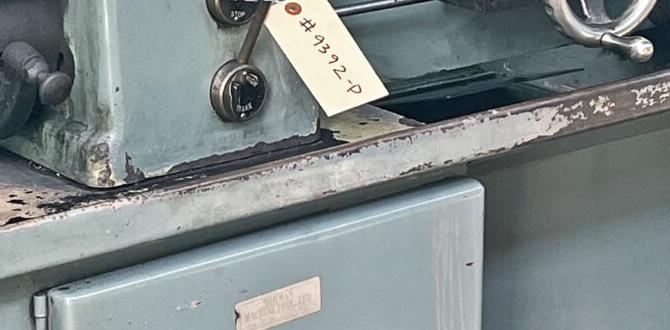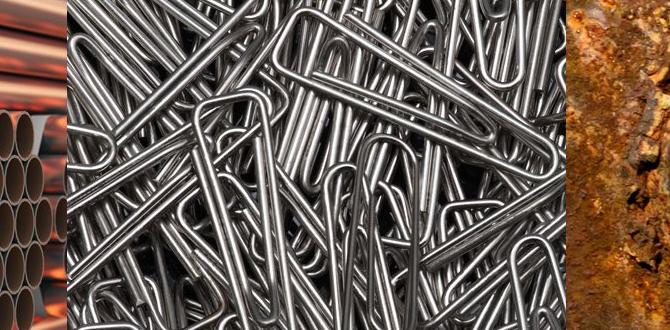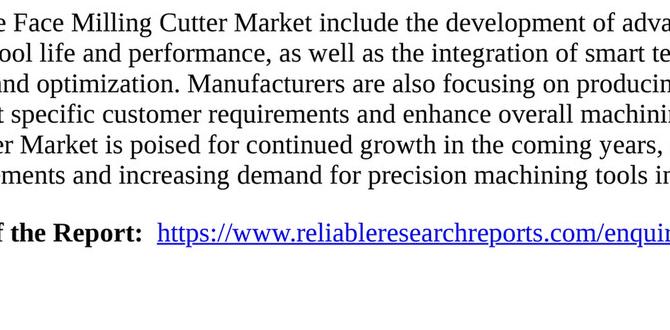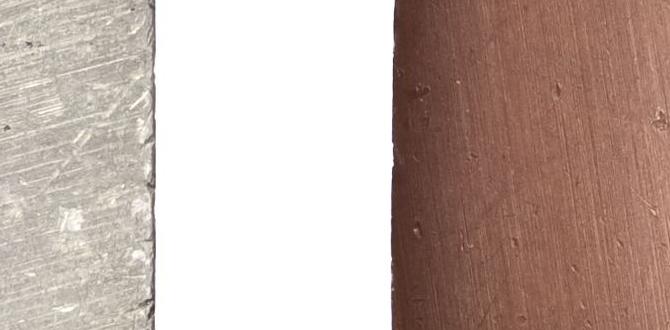Carbide end mills are essential for machining stainless steel because their hardness and heat resistance allow them to cut this tough material effectively and efficiently, preventing tool wear and ensuring a good finish.
Cutting stainless steel can feel like a wrestling match. It’s a strong, durable metal, and trying to machine it with the wrong tools can lead to frustration, broken cutters, and a less-than-perfect finish. Many beginners wonder if there’s a secret weapon for tackling stainless steel. The good news is, there is! It’s a special type of cutting tool that makes all the difference. Let’s dive into why this tool is so important and how it can make your stainless steel projects a breeze. We’ll cover everything you need to know to get started.
What is a Carbide End Mill?
Simply put, a carbide end mill is a type of cutting tool used mostly in milling machines. Think of it as a rotating drill bit, but with multiple cutting edges along its sides and end. This design allows it to cut horizontally, vertically, and plunge into material, making it incredibly versatile.
What makes it special, especially for tougher materials like stainless steel, is what it’s made from: tungsten carbide. This super-hard material is much harder than the High-Speed Steel (HSS) used in many other cutting tools. This hardness translates directly into a tool that can withstand higher temperatures and pressures, which is exactly what you need when cutting something as stubborn as stainless steel.
Why Stainless Steel is a Challenging Material
Before we talk about why carbide end mills are the heroes of stainless steel machining, let’s understand why this metal is so tricky. Stainless steel earned its name because of its excellent corrosion resistance, largely due to its chromium content. However, this same chromium, along with other alloying elements like nickel, makes it significantly harder and tougher than regular carbon steel.
Here’s a breakdown of what makes stainless steel tough to machine:
High Strength: Stainless steel has a high tensile strength, meaning it resists deformation and requires more force to cut.
Work Hardening: As you cut into stainless steel, it tends to get harder near the cut surface. This phenomenon, called work hardening, makes subsequent cuts even more difficult.
Low Thermal Conductivity: Stainless steel doesn’t dissipate heat very well. This means that the heat generated by the cutting action gets trapped right at the cutting edge, leading to rapid tool wear if not managed.
Gummy Nature: Some stainless steels can be “gummy,” meaning they tend to stick to the cutting tool rather than cleanly shearing away. This can lead to poor surface finishes and tool jamming.
Trying to mill stainless steel with standard HSS end mills often results in the tool quickly becoming dull, overheating, or even breaking. This is where the superior properties of carbide come into play.
The Magic of Carbide: Why It’s Essential for Stainless Steel
Carbide end mills are the go-to choice for machining stainless steel for several key reasons, all stemming from the inherent properties of tungsten carbide:
1. Superior Hardness
Tungsten carbide is one of the hardest materials known, second only to diamond. Its extreme hardness means it can maintain its cutting edge much longer than HSS, even when subjected to the abrasive nature of stainless steel. This allows for more consistent cutting and a better surface finish.
2. Excellent Heat Resistance
Machining generates heat. Stainless steel, with its low thermal conductivity, traps this heat at the cutting edge. Carbide’s high melting point and ability to retain hardness at elevated temperatures mean carbide end mills can operate effectively at higher cutting speeds and feeds without rapid degradation. This is crucial for managing the heat generated when cutting stainless steel.
3. Increased Rigidity
Carbide is a denser and more rigid material than HSS. This rigidity helps to minimize tool deflection, leading to more accurate cuts and reducing the risk of chatter (vibration) which can damage the workpiece and the tool.
4. Higher Cutting Speeds and Feeds
Because carbide tools can handle the heat and hardness of stainless steel, you can generally use faster cutting speeds and deeper feeds. This significantly increases productivity, allowing you to remove material more quickly. For a hobbyist or professional alike, this means completing projects in less time.
5. Better Surface Finish
When a carbide end mill is sharp and used correctly, it can produce a very smooth surface finish on stainless steel. This is often because it cuts cleanly rather than deforming the material as much as a softer tool might, and it maintains its edge integrity for longer.
Key Features to Look for in Carbide End Mills for Stainless Steel
Not all carbide end mills are created equal, and some are better suited for stainless steel than others. Here are the features to consider:
1. Material Coating
Coatings add an extra layer of protection and performance to end mills. For stainless steel, some popular and effective coatings include:
TiN (Titanium Nitride): A general-purpose coating that improves hardness and reduces friction. Good for some stainless steels but not the ultimate choice.
TiCN (Titanium Carbonitride): Harder than TiN and provides better wear resistance, making it a good step up for stainless.
AlTiN (Aluminum Titanium Nitride): Excellent for high-temperature applications and materials that generate a lot of heat, like stainless steel. It forms a protective aluminum oxide layer at high temperatures, preventing the tool from welding to the workpiece. This is often the best choice for machining stainless steel.
2. Number of Flutes
Flutes are the spiral valleys that run along the cutting edge of the end mill. They carry chips away from the cut.
2-Flute End Mills: These offer more chip clearance, making them ideal for plunging and slotting operations, especially in gummy materials like stainless steel. The larger space between flutes helps prevent chip packing.
3-Flute End Mills: Offer a good balance between cutting edge engagement and chip clearance. They can be used for general-purpose milling.
4-Flute End Mills: Provide more cutting edges for faster material removal in less demanding applications. However, they have less chip clearance, which can be an issue with sticky materials like stainless steel, potentially leading to chip welding or packing.
For machining stainless steel, especially in initial setup, 2-flute or 3-flute end mills are generally preferred to manage chip evacuation and prevent overheating.
3. Helix Angle
The helix angle is the steepness of the flutes.
Standard Helix (30 degrees): Good for general-purpose milling of a wide range of materials.
High Helix (45 degrees or more): Features steeper spirals, which contribute to smoother cutting action and better chip evacuation. They are often excellent for softer or gummy materials like aluminum and some stainless steels, as they can “lift” chips out more effectively.
4. End Mill Type
Square End Mills: The most common type. Used for general milling, profiling, face milling (with limitations), and creating pockets.
Ball Nose End Mills: Have a rounded tip, perfect for creating 3D surfaces, contours, and fillets.
Corner Radius End Mills: Have a small radius at the cutting corners. This strengthens the cutting edge, making it more durable and reducing the risk of chipping, which is beneficial when working with tough materials.
5. Shank Diameter and Length
Shank Diameter: This is the part of the tool that goes into the collet or holder. Common sizes include 1/8 inch, 1/4 inch, 1/2 inch, etc. Ensure it matches your machine’s collet system.
Standard Length: Refers to the overall length of the tool, including the cutting length and shank. For stainless steel, using shorter, more rigid tools whenever possible is generally better to minimize deflection.
Recommended Carbide End Mills for Stainless Steel Hobbyists
For beginners working with stainless steel on smaller machines like benchtop milling machines or CNC routers, consider starting with:
Size: 1/8 inch or 1/4 inch shank diameter.
Type: 2-flute or 3-flute carbide end mill.
Coating: AlTiN coating if available, or TiCN.
Geometry: Square end mill with a standard or high helix angle. A small corner radius can add durability.
Look for brands known for quality machining tools. Reputable manufacturers often provide detailed specs and recommended applications for their end mills.
Setting Up Your Milling Machine for Cutting Stainless Steel
Using the right tool is half the battle. The other half involves proper setup and understanding cutting parameters.
1. Machine Rigidity and Workholding
Stainless steel requires a rigid setup. Ensure your milling machine is in good condition, with minimal play in the Z-axis (up/down) and X/Y axes (side-to-side).
Workholding: Secure your workpiece firmly to the machine table. Use good quality clamps or a vise. Avoid any movement or slippage, as this will lead to poor results and can break your end mill. Double-sided tape is generally not sufficient for stainless steel.
2. Spindle Speed (RPM) and Feed Rate
These are the most critical parameters. Too fast a spindle speed or feed rate, and you’ll overheat or break your tool. Too slow, and you risk rubbing the tool and generating heat without cutting effectively.
Spindle Speed (RPM): For carbide end mills in stainless steel, you’ll typically use lower RPMs than you would for softer metals like aluminum. A good starting point might be anywhere from 200 to 1500 RPM, depending on the diameter of the end mill and the specific stainless steel alloy.
Feed Rate (IPM or mm/min): This is how fast the tool moves through the material. It’s directly related to RPM and the number of flutes. You want to hear a consistent, light “sizzling” sound, not a loud screech or a grinding noise. The feed rate should be fast enough to create a chip, rather than rubbing.
Finding the right combination often involves consulting the end mill manufacturer’s recommendations or using online calculators. A great resource for understanding these parameters is the National Institute of Standards and Technology (NIST), which offers data on machining steel and its alloys.
Example Cutting Parameters (for a 1/4″ Carbide End Mill in 304 Stainless Steel):
These are general guidelines and may need adjustment based on your specific machine, tool geometry, and coolant.
| Parameter | Typical Value | Notes |
| :————— | :—————– | :—————————————————————– |
| Spindle Speed | 500 – 1000 RPM | Lower RPMs for roughing, higher for finishing. |
| Feed Rate | 5-15 IPM (0.12-0.38 m/min) | Adjust for chip load. Aim for a light, crisp chip. |
| Depth of Cut | 0.020 – 0.060 inches (0.5 – 1.5 mm) | Smaller depths are safer for beginners. |
| Width of Cut | 0.050 – 0.100 inches (1.2 – 2.5 mm) | Avoid full-width cuts (100% stepover) when possible. |
| Coolant/Lubricant | Flood or Mist Coolant | Essential for heat management and chip evacuation. |
Remember, it’s always better to start conservatively – lower speeds and feeds – and gradually increase them until you find the optimal balance.
3. Coolant and Lubrication
Cutting stainless steel generates significant heat. Without proper cooling, the tool will overheat, lose its hardness, and the stainless steel will become even harder and gummier.
Flood Coolant: A stream of coolant directly onto the cutting area is ideal. It cools the tool and workpiece and flushes chips away.
Mist Coolant (MQL – Minimum Quantity Lubrication): A fine spray of coolant and air. Less messy than flood and can be very effective.
Cutting Fluid/Paste: For manual machining, specialized cutting fluids or pastes can be applied directly to the tool’s cutting edge. These help lubricate the cut and reduce friction and heat.
Using a good quality cutting fluid specifically designed for stainless steel can make a world of difference.
How to Use a Carbide End Mill for Stainless Steel: Step-by-Step
Let’s walk through a common scenario: milling a simple pocket or slot in a piece of stainless steel.
Tools You’ll Need:
Milling machine (manual or CNC)
Carbide end mill (appropriate size and type, e.g., 1/4″ 2-flute AlTiN coated)
Collet or tool holder that fits your machine and end mill shank
Workpiece (stainless steel)
Clamps or vise
Safety glasses and hearing protection
Coolant or cutting fluid
Calipers or a measuring tool
Wrenches for tightening collet/holder
Steps:
1. Prepare Your Machine: Ensure your milling machine is clean, lubricated, and in good working order. Check for any excessive play in the axes.
2. Secure the Workpiece: Clamp your stainless steel workpiece firmly in the vise or to the machine table. Make sure it’s flat and stable. Misalignment can lead to broken tools.
3. Install the End Mill: Insert the carbide end mill into the appropriate collet or tool holder. Ensure the shank is clean and free of debris. Tighten the collet securely in the spindle.
4. Set Up for Z-Axis Zero: Lower the spindle until the tip of the end mill is just touching the top surface of your workpiece. You can use a piece of paper – when you can feel just a slight drag on the paper as you move it between the end mill and the metal, you’re at zero. Lock your Z-axis or set your Z-zero in your CNC controller.
5. Set Up for X/Y-Axis Zero: Position the end mill over one corner of your desired cutting path or over the center of where you want to start. You can use the machine’s DRO (Digital Readout) or your CNC controller’s position system to set your X and Y zero.
6. Determine Cutting Parameters: Consult manufacturer data or online calculators for recommended spindle speed (RPM) and feed rate (IPM) for your specific end mill size, material, and operation. For a 1/4″ 2-flute carbide end mill in 304 stainless steel, a starting point might be 800 RPM and 10 IPM with a light depth of cut.
7. Apply Coolant/Lubricant: Turn on your flood or mist coolant system, or apply cutting fluid manually. This is critical!
8. Begin the Cut – Plunging (if applicable): If your operation requires plunging the end mill into the material (like starting a pocket), do so slowly and using a dedicated plunge feed rate, which is typically much slower than the XY feed rate. Many CNC controllers have specific peck drilling cycles for this. On a manual machine, you would feed down very slowly.
9. Begin the Cut – Linear Milling: Engage the X or Y axis to move the end mill through the material at your set feed rate. Ensure the sound of the cut is consistent – a light, crisp chip sound. If it sounds like it’s grinding or screaming, stop immediately and check your settings or the tool.
10. Depth of Cut: For initial passes, especially with a beginner setup, use shallow depths of cut. For a 1/4″ end mill, try 0.020 inches (0.5 mm) per pass. You can increase this as you gain confidence and see how the tool performs. For slotting, aim for a width of cut (stepover) that is significantly less than the end mill diameter, ideally 50% or less, to reduce sideways cutting forces.
11. Chip Evacuation: Periodically clear chips, especially if not using an effective coolant system. Ensure the flutes are not becoming packed with material, as this can lead to overheating and tool breakage. You might need to retract the tool and clear chips manually or use an air blast.
12. Completing the Operation: Continue milling, making multiple shallow passes if necessary to reach your final depth. If you are profiling or milling a pocket, you will likely need to make several passes to remove all the material.
13. Clean Up: Once the milling is complete, turn off the spindle and coolant. Carefully remove the workpiece and clean your machine and tools. Inspect the end mill for wear.
Safety First!
Always wear safety glasses. Flying chips are a real hazard.
Wear hearing protection. Milling can be loud.
Keep hands and clothing away from rotating machinery.
Never touch a tool or workpiece immediately after cutting; it will be hot.
Understand your machine’s emergency stop.
Common Problems and Solutions When Milling Stainless Steel
Even with the right tools, you might run into issues. Here’s how to troubleshoot:
Tool Wearing Out Too Quickly:
Problem: The end mill is dulling rapidly.
Causes: Running too fast (speed or feed), insufficient coolant, work hardening from previous passes, workpiece material is harder than expected.
Solutions: Reduce RPM and/or feed rate. Ensure adequate coolant flow. Increase depth of cut slightly to get below the work-hardened layer (if feasible and rigidity allows). Check if you’re using the right type of carbide end mill for the specific stainless alloy.
Poor Surface Finish (Rough or Gummy):
Problem: The surface is not smooth, or material is sticking to the tool.
Causes: Dull tool, incorrect cutting parameters (too slow chip load), insufficient coolant, tool chatter,







